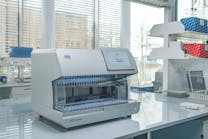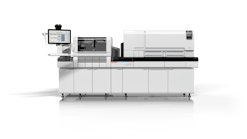A shortage of skilled laboratory workers has been decades in the making—the result of a retiring workforce and a shrinking number of accredited training programs. With a growing population sending more samples to the laboratory and a shortage of staff to handle those samples, lab managers consequently are facing a number of challenges. From maintaining control over the influx of samples and finding ways to improve workflow to deliver patient results in a timely manner, to identifying growth opportunities to generate new revenue to make up for decreasing reimbursement rates, the pressure on lab managers to sustain their laboratory operations is mounting. This article will explore the evolving staffing crisis, stakeholders’ views on laboratory technology, and the impact that automation can have on both laboratory operations and the overall health system to drive outcomes that matter to patients.
State of the crisis and other challenges
The Bureau of Labor Statistics expected medical laboratory technologist and technician employment to grow by 13 percent between 2010 and 2020.1 According to the American Society for Clinical Pathology’s (ASCP) 2016-2017 Vacancy Survey of Medical Laboratories, retirement rates of laboratory professionals across all major departments are at their highest since 2012.2 Yet the data also suggest that the number of students graduating from accredited training programs is not sufficient to meet the demand.
The main concern in the laboratory workforce, according to the study, is staffing the laboratory with qualified laboratory professionals. These respondents also indicated an extremely low number of applicants compared with the number of personnel retiring. Further adding to the deficit, the number of laboratory training programs available to students interested in pursuing this field also has decreased, by nearly 25 percent since 1990.1
The Baby Boomer population will continue to age and the demand for testing will rise, but the number of laboratorians with the training required to run IVD tests remains stagnant.
While the staffing shortage and aging population are challenges that have long been on the horizon, the rising trend of healthcare facility consolidation as well as recent policy initiatives have hastened the need for solutions that will sustain laboratory operations long-term. Most recently, with the Centers for Medicare and Medicaid Services’ implementation of the Protecting Access to Medicare Act (PAMA), clinical laboratories large and small have been experiencing the most significant reduction in reimbursement in decades. PAMA is forcing laboratories to reduce costs, maximize revenue, and figure out ways to increase testing volume to make up for lost revenue. Private insurers are expected to follow suit and decrease their reimbursement rates, too.4
All of these challenges equate to an increasing workload—in the context of an imperative not to sacrifice turnaround time—with less financial and staffing support.
The rise of automation
Recognizing the impending challenges on the horizon, IVD manufacturers have begun rolling out automated solutions with varying capabilities to support laboratories and their growing operations. Increasingly, labs are transitioning from buying individual analyzers to purchasing total solutions from a single trusted partner. Total solutions encompass a variety of offerings, including equipment for sample management, a broad menu of assays, IVD analyzers, automation systems, and informatics. Taken together, such total solutions are designed to anticipate and address the emerging needs of clinical laboratories.
Recognizing that total lab automation can be a significant investment for any lab to undertake all at once, manufacturers have deployed a number of resources and affordable solutions to help laboratories transition into automation. Innovative instrument features such as automated quality control and calibration, sophisticated vision systems, intelligent sample management and test scheduling, and bidirectional magnetic sample transport technology optimize the workload for highly skilled operators. Less hands-on time for routine tasks maximizes existing resources to help refocus skilled attention elsewhere in the lab and reduces the need for additional operators as laboratory operations grow.
Optional becomes must-have
Automation offers laboratories standardization and consistency—two benefits that can no longer be overlooked, because the consequences of overlooking them are increasingly detrimental to patient safety. Stakeholders agree. During a recent study to determine the value of the lab to the health system, research that involved more than 300 U.S. lab directors, internists, and emergency room physicians, more than three-quarters of doctors and lab directors agreed that labs play a vital role in healthcare systems and are a critical component of patient diagnosis and treatment. Additionally, more than half of the physicians and internists noted that investments in lab technology would be very impactful on improving diagnoses, and about half of physicians and internists thought that such investments would be very impactful on improving patient safety and patient outcomes.3
As further support for the case for automation, an ASCP study revealed that the increasing workload in the laboratory is compelling laboratory managers to hire lower-level applicants immediately after graduation or candidates with bachelor’s degrees but not laboratory training.2 Lack of training exposes patients to significant risks—for example, failure to recognize critical results. With more than 70 percent of clinical decisions being guided by test results, the laboratory must progress to continue delivering quality results. With the right infrastructure and software behind it, automation can improve workflow efficiency and turnaround time and reduce errors.
Lobbying for the lab
Hospital lab directors claim that their biggest challenges include financial constraints related to operations, investments in lab technology, and automation.3 Laboratory technologies often are deprioritized over other expenses that are thought to more directly impact patients. The direct and indirect impact of laboratory diagnostics, however, is undeniable. These technologies play a pivotal role in the patient’s experience and outcomes and in the hospital’s reputation. This value often goes unrecognized by hospital decision makers because, without visibility beyond the laboratory silo, lab managers often are not equipped with the information they need to argue for investment dollars.
IVD tests play a critical role in detecting, diagnosing, and monitoring disease, providing undeniable value to both patients and the healthcare system in general. The financial value is not lost on hospital workers. The majority of emergency medicine physicians (73 percent), hospital lab director/pathologists (81 percent), and internists (60 percent) agree that increased investment in technology for IVD labs can lead to overall hospital cost savings and increased revenue.3
Armed with that evidence, following are three strategies that can help support lobbying efforts for new technology for your lab:
Consider a workflow consultant: The most successful lab transformations occur as a result of staff input, alignment, and adaptability—all of which require communication. Consider the help of a workflow consultant. A workflow consultant is an expert trained to methodically analyze a laboratory’s productivity objectively and offer solutions for improvement. This professional adds value to the project team by conveying to decision makers cost justifications for modifications based on process improvement methodologies and case studies from other projects with similar goals.
Utilize a project manager: A project manager is an expert certified to coordinate the technical and physical aspects of implementation, resources management, and third-party management. The project manager works hand-in-hand with the workflow consultant and is responsible for validating project milestones andtiming, and for adhering to budget compliance.
Implement change management: Change management helps you develop a plan that will assist you in leading the successful implementation of new technology in conjunction with optimized workflow processes. By focusing on the human side of automation, this process allows you to overcome resistance to change and lead a successful change initiative. A change management initiative helps determine which key stakeholders are part of the core project team, how to manage the transition of an active lab automation system with minimal disruption to operations, and how to maintain workflow during the transition.
The long view
Investing in advanced technology can contribute to financial savings for healthcare institutions down the road. Hospitals in the United States that incorporated innovative medical technologies have Medicare Spending per Beneficiary (MSPB) scores below the national average. Sixty-five percent of top technology hospitals, as defined by U.S. News & World Report, have an average MSPB score below the national average, compared with 56 percent of nontechnology hospitals.5,6
More broadly, the escalating staffing crisis and other challenges that contribute to an increasing workload are demanding innovation to keep up with rising test volumes. Data collected from stakeholders across the health system reveal that stakeholders are supportive of investment in laboratory automation technology, but competing projects may deprioritize investing in new laboratory services and technologies, causing opportunities for workflow efficiency, physician satisfaction, and improved patient experience across the entire health system to be missed. To turn interest into implementation, leveraging the help of a trusted partner, you can develop a strategy that will focus stakeholders’ attention on the impact automation can have on both laboratory operations and the overall health system to help reprioritize funding appropriately.
REFERENCES
-
- Rothenburg I. Responding to the continuing personnel shortages in laboratory medicine. Lab Testing Matters website.
- Garcia E, Kundu I, Ali A, Soles R. The American Society for Clinical Pathology’s 2016-2017 vacancy survey of medical laboratories in the United States. Amer J Clin Path. 2018; 149(5): 387-400.
- Siemens Healthineers. Whitepaper. The Diagnostic Lab: The Hidden Jewel in the Health System. 2017.
- Burns J. CMS issues PAMA final rule that aims to cut Medicare’s clinical laboratory test price schedule sharply beginning in 2018. Dark Daily July 18, 2016.
- McMullen L. U.S. News ranks best hospitals 2012-2013. U.S. News & World Report. 2015.
- Sullivan E. New study finds average Medicare spending for top technology hospitals matches national rate. Avalere Health LLC.





